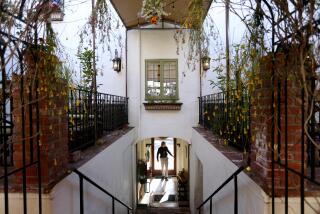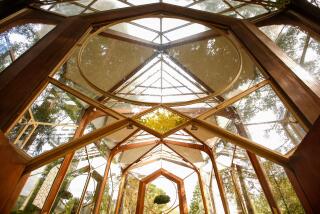On a Mission to Give Mission Away : Owner Seeks to Have Arizona Colonial Buildings Restored
GUEVAVI RANCH, Ariz. — He has been worrying about the 18th-Century Spanish Colonial mission ever since he bought the ranch 33 years ago.
“I always worry about it. I have been protecting the mission from treasure hunters, pot hunters and vandals all these years,” sighed Ralph Wingfield, 76, as he stood in the crumbling ruins of Los Santos Angeles de Guevavi Mission Church, erected in 1751.
“Time is slipping by. I’m not getting any younger. In my mind I have always thought I would like to see the mission restored before I die,” said the 6-foot-1, 260-pound, silver-haired rancher.
Wingfield is probably the only American with a historic Spanish mission in his backyard.
Guevavi Mission is on Wingfield’s 75,000-acre Guevavi ranch not far from his century-old, eight-bedroom home, 10 miles north of the Mexican border.
Tends to Cattle
A life-long rancher, Wingfield runs several hundred head of cattle on his huge spread in Arizona’s Santa Cruz County. He is up at 4 a.m. every day and works until sundown doing what he likes best, caring for his cattle, running his ranch.
“I have tried to interest the Catholic Church, the National Park Service, historical societies and others in the mission. I’m willing to donate the church ruins and surrounding land with mission building foundations providing I am guaranteed the site will be preserved and protected,” said Wingfield. “But so far I have had no takers. . . .”
This morning, Stewart L. Udall, a Phoenix attorney and former secretary of the interior, will head up a visit by the board of directors of the Archaeological Conservancy to Wingfield’s ranch to discuss the possibility of acquiring the historic site.
The year was 1691.
Eusebio Kino, 46, an Italian Jesuit priest educated in Germany withdegrees in theology, mathematics and astronomy, rode into the primitive Pima Indian village on horseback with another Jesuit, Juan Maria Salvatierra.
Kino and Salvatierra were the first Europeans to visit Guevavi, which in Pima means big spring.
It was 10 years earlier that Kino had arrived in Mexico from Spain. He spent his first three years in the New World establishing missions in Baja California. It was Kino who discovered that Baja California was a peninsula, not an island as had been thought.
Next, Kino went to northern Sonora to establish missions and bring Christianity and education to the Seri, Pima and Papago Indians. That is what brought him to Guevavi, the Jesuit outpost he established in present-day Arizona.
Kino visited Guevavi a couple of times each year for the next 10 years and assigned another Jesuit as resident priest in the Pima village in 1701. That priest, Juan de San Martin, built the first mission church in the village and a rectory that year.
Settlement Thrived
In 1751 a new and larger mission church was erected. Portions of that structure’s three-foot-thick adobe walls still stand on Wingfield’s ranch.
Guevavi thrived as a frontier settlement of New Spain, home for 1,400 Pima Indians, a center for Spanish soldiers, ranchers, miners and the Jesuit missionaries.
There was a wall around the mission complex within which were the church, the school, the rectory, other houses, stables, and storage structures. There was the Campo Santo (holy field), the mission cemetery.
In the mission church standing in ruins on Wingfield’s ranch and in the previous church hundreds of Indians were baptized. Masses were celebrated. There were weddings and funerals.
One of the Jesuits, Johann Baptist Grazhoffer, 42, who died in 1732, was poisoned by the Indians. Many of the Indians buried on the mission grounds perished from diseases contracted from the Europeans.
In 1767 the Jesuits were expelled from Mexico by the Spanish government and the mission at Guevavi was abandoned. The mission ruins are the only visible sign of the village today other than building foundations.
Fifteen miles north of Guevavi is the mission church at Tumacacori, completed in 1820. When Guevavi was a mission, Tumacacori was a Jesuit visita , a place where missionaries occasionally held services.
The Franciscans, who established the 21 California missions, built the mission at Tumacacori, which is fairly intact today.
Tumacacori has been a National Monument since 1908. At Tumacacori, National Park Service historian Nicholas Blesser, 54, emphasized the importance of Guevavi:
“It was a significant mission, much more important, for example, than Tumacacori. Guevavi was the only Spanish Jesuit mission in the United States. It should be preserved and protected. It was recommended in the National Park Service 1975 master plan that it be included in the national park system.
“But the money necessary to preserve and protect the mission ruins has not been available,” said Blesser.
Wingfield and John Wayne were close friends. Wingfield has photographs of himself and Wayne at his ranch. They owned an adjoining ranch together and sailed around the world on the actor’s yacht.
“John Wayne knew how I felt about the old mission. He agreed with me. He thought it ought to be preserved and restored to what it was like when the Jesuits built it,” the rancher said as he dodged a mesquite bush growing in the mission ruins.
The rancher led the way along the ruts of an old wagon trail to the banks of nearby Santa Cruz River. He stopped and pointed: “What I would like to see is the government or somebody come in here and for them to build a bridge across the river giving access to the mission.”
He noted rock formations of several other structures that surrounded the church. “If somebody would restore the mission I’d be willing to give them seven acres of land, the area that contains all the foundations for the mission complex.
Tales of Buried Treasure
“Can you imagine what life must have been like in the 1700s out here? You know Kino brought the original cattle, horses and mules into this country,” Wingfield said.
He pointed out a deep hole recently dug by treasure hunters.
“They sneak in here and dig for a mythical buried treasure. Stories appear in treasure magazines saying there is a cache of gold buried in an old Spanish mission in southern Arizona,” he said.
“There are many graves. Not long ago somebody dug up the remains of a woman and scattered her skull and bones on the ground. We had a priest come out and rebury her in a dignified manner.
“If I didn’t keep an eye on this place there wouldn’t be anything left. It just makes me sick the way people come in here and tear things apart. . . .”
Wingfield has read everything available about Kino and the Jesuit experience in Guevavi and northern Sonora. He is in contact with mission experts. He is favorable toward any scientific work at the site.
In 1968-69, archeologist John L. Kessell of the University of Arizona dug up a number of artifacts, coins, plates, pots, crucifixes, etc., at Guevavi, which are on loan to the university from Wingfield. Kessell is the author of “Mission of Sorrows--Jesuit Guevavi and the Pimas 1691-1767,” published in 1970 by the University of Arizona.
Meeting with Wingfield today at the mission ruins will be Mark Michael, president of the Archaeological Conservancy and members of the organization’s board of directors.
The Archaeological Conservancy, based in Santa Fe, was founded in 1980. It is modeled after the Nature Conservancy and serves as a bank to keep archeological sites until they can be taken over by a government agency, university or historical society with the resources and commitment to protect, preserve and maintain them.
James B. Walker, 34, southwest regional director of the Archaeological Conservancy, and others have had preliminary discussions with Wingfield about acquiring the site. “The board of directors is holding its annual meeting in Phoenix on Saturday and is coming here to see the mission property,” Walker said.
“Ruins on state and federal land are pretty well protected by law. But archeological ruins on private property are completely unprotected. It is up to the individual owner as to what happens to ruins on private property.
“If we were to get title to Guevavi Mission, we would go in and fill holes dug by looters, fence the property, stabilize the ruins and try to stop any future erosion on the site.”
More to Read
Sign up for Essential California
The most important California stories and recommendations in your inbox every morning.
You may occasionally receive promotional content from the Los Angeles Times.










